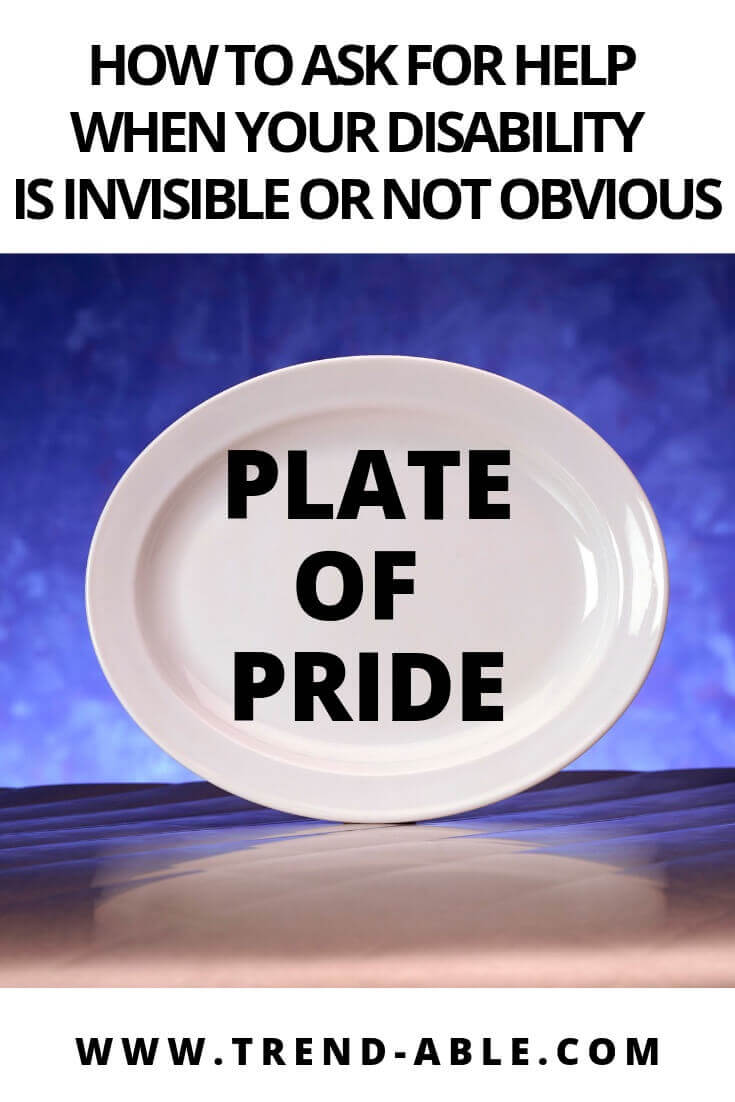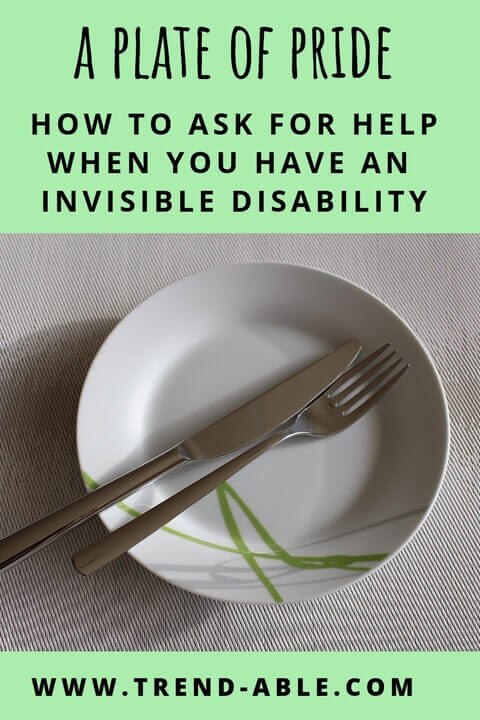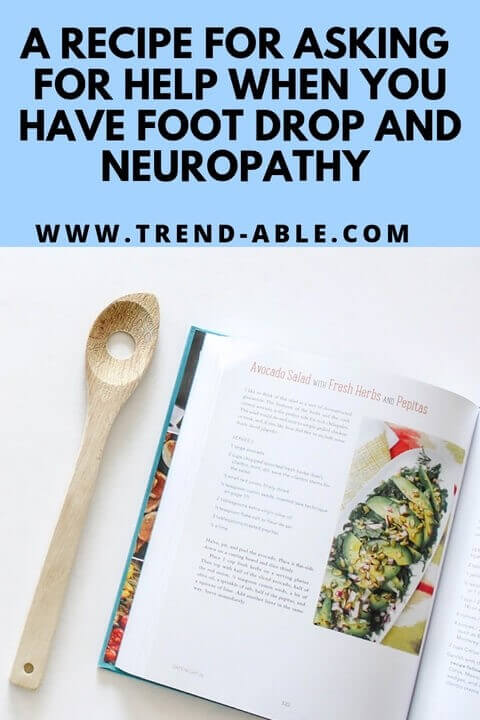This is my recipe for how to ask for what you want when you have a disability.
Disclaimer:
I don’t cook. In fact, true story, when my twin step-daughters were home from college for the holidays they opened the oven to bake cookies and found a cookie sheet filled with shriveled up, burnt, miniature hot dogs inside. Apparently, I must have forgotten to serve that second tray of appetizers at the party we had almost two months prior. With that said, I am not your go-to cooking expert. You should feel free to adjust any ingredients needed and modify any recipe I ever give you.
Key Ingredients
Confidence, Humility, Honesty, Empathy & Humor
5 CUPS OF CONFIDENCE
The most important ingredient for getting what you want and need when you have non-obvious physical challenges is confidence. It’s the base that every other ingredient adheres and mixes into.
Confidence is not a fast food item that you can easily find. It must be grown and nurtured in-house. Everyone has the ability to get confidence, but some people have easier access, and more resources.
Confidence is not seen; it is felt. A person with a disability can shout it from a rooftop wearing an “I have a disability” or, “I survived _____,” but still lack true self-confidence. This can be all show. Likewise, a person can conceal her leg braces, or large scars, and be über self-assured and not want, or need, an exterior label.
Confident people can, and do, have insecure moments. No one is 100% confident in every situation. A confident person knows this and owns her insecure feelings. Learn more about building confidence in my post How To Photoshop Your Self-Image.
2 CUPS OF HUMILITY
It is never easy asking people for help to do seemingly easy tasks. This is especially true if you’re a Type A person like myself.
But, we have to remind ourselves that able people are not mind-readers and unless a person has physical challenges of her own, she cannot intuitively get your need for an arm to hold for balance, or your need, rather than want, for that close-to-the-exit space in barre class.
Swallowing our pride doesn’t have to cost us anything. In fact, it can be low, or 0, calories if we remember to use a sugar substitute. We are not entitled to the space in exercise class or the lounger closest to the pool. No one wants to help people they find to be rude and condescending.
We may need it and want it, but in order to get something when someone else already has it, we must be kind and “use our words,” as you hear the moms of young children lecture. We also must accept the fact that 99% of the time people will do the right thing when we ask them for something in a respectful way. We should not give any of our power away to the 1% of people who won’t. This is something I struggle with (just ask the guy who took my lounger at a certain Miami resort and is probably throwing darts at my photo), but I’m working on it.
2 CUPS OF HONESTY
Mix in equal parts humility and honesty. I would recommend the organic kind, found in non-processed, real-food stores.
When I used to make up stories about walking funny because of a “sports injury,” I felt good about myself for about 5 minutes. I was trying so hard to be something that I mistakenly thought made me look and seem better. I was trying to be a perfect person who had that perfect kind of person accident on a ski slope somewhere in Aspen.
Perfectionism is actually more about the fear of not being accepted or good enough. People try so hard not to show the things about themselves that in reality make them more likable and relatable to others.
Telling your story does not have to define your forever interactions with people. But, if you are honest with people and tell it, (but don’t overdo it) it can, and will, make you closer.
2 TABLESPOONS OF EMPATHY
Try not to make assumptions and be judgmental about someone else’s cart. If you knew I had physical limitations and saw my basket filled with overpriced, prepared, specialty-store foods, you might assume I can’t cook. Ok, well that’s true, as you already know, but you get the point. You may think it has something to do with my physical challenges when in reality it’s more a preference than a limitation. Don’t worry, my kids’ dad cooks and they are well nourished 50% of the time.
In order to get what you want from others in a way that feels good for both parties, you need to get out of your own head and also be aware of what others may want and need.
We never really know what’s going on in other people’s lives. If you want people to begin understanding your cues, then start paying attention to theirs. Everyone has stuff.
A PINCH OF HUMOR
Humor is the ultimate dipping sauce for everything. It gives bland items flavor and makes delicious french fries taste even better.
When asking for help with something, like carrying your plate of food for you in a buffet line, make a joke to ease your discomfort. Say for example, “Do you mind helping me carry this plate to my table? I know if I try with my poor balance, it’s gonna end up all over that woman in the white dress.”
THE SECRET SAUCE
Asking for help takes practice. Try taking very small bites and chew slowly.
You can learn to ask for what you want without feeling like you’re a weak person for doing so. In fact, by using the right mix of ingredients, you will feel far more confident, happier, and have higher quality interpersonal relationships.
As a wise person once said, “You can do anything, but not everything.” Be that badass woman who is smart and self-reliant enough to ask for help when you need it.





Hi, new to your very inspiring blog. I lenjoy reading your thoughts and views, expressed elequontly and obviously well thought out.
I’m also an “exceptional” person, just like you, with a chronic neuromuscular disorder that has been altering my body, slowly, since I was a teenager. I practice meditation and find that I usually close my eyes, breathe in and I envision this woman walking down an empty beach, she’s tall slender with long strong legs. It’s me. I feel that even though I don’t resemble that woman anymore, that is still me. Walking on the sand, on my toes, looking straight ahead at the endless beach. The magnificence of existence. I was a ballet dancer when I first started having symptoms. I had beautiful feet, for a long while. Long strong calves that my husband always adored. That’s still me. I have poise, try to, a big smile for everyone, I don’t need to explain anything about me. I have unlimited reserves of pride. I want to feel stunning. There’s so much struggle and pain in this existence…but we all have a so called deformity. Life is worth living. Be who you are, inside, the girl with all the gifts.
Hi Betti,
Thank you so much for your very thoughtful & beautiful comment. I am a big believer that we are how you think we are. You are still that stunning long legged dancer – just packaged a bit differently. Xo
Sometimes people ask if they can help me and I’ve learned to just say YES. It often seems they need to help me more than I need help. This has led to many rich and pleasant interactions. I figure I can always do it myself the next time.
Once a young college student asked if he could help me cross the street. This was a first for me! But I just “Sure” and holding on to his arm, we started a lively chat, which was good for both of us.
Liz,
I loved your comment & completely agree that people sometimes need to do the helping more than those receiving need their help. You are giving some a lot more than just good conversation. Thank you so much for reading ?
Hey! Thanks so much for your blog and the shoe recommendations. I am a 13 year old girl with CMT. I find your blog relatable and funny. The whole “granny comfort shoes” was hilarious because I find myself in the same boat. My CMT is mostly in my feet, I also have trouble carrying things that require both hands and carrying heavy things. The shoes you reccomend are cute and also accessible which is great. I also like this section because as a teenager its difficult and embarrassing for me to ask for help.
Thanks for the help.
Heather, loved getting your email. You are so articulate and resourceful at 13…? Thanks for the awesome compliments & I’m so glad you find the blog helpful and me, an old lady, kind of funny. I hope you follow on Instagram @Trend.Able as there are a ton of teenagers who follow me who also have CMT including my own daughter. Also, would love to see your face. ?
Spot on.
I recently had my routine every 4 month checkup with my neuromuscular neurologist, where I voiced my opinion of the God ugly and screwed up set the were calling braces, which I was wearing. This being the 3rd pair I have been put in, my mouth opened wider to show my distaste of what I was wearing. So, I asked my doctor if I could wear workboots in lieu of the horrow show on my feet and legs now. To my surprise she said yes! Not to only work boots, but to hiking boots and cowboy boots, all which will have my orthotics inside. So now I own a pair of bluish-purple_navy hiking boots and CAT periwinkle work boots, and I couldn’t be happier.
Please keep people like us in mind who are using our personal orthotics in a boot type structure. Maybe someday this system won’t work for me, but for now it does.
Lois, I think I replied to you privately but if not, I will defnitely keep this in mind. Thanks, Lainie
Thanks so much for clearly voicing thoughts for so many of us!… I have a question regarding wearing boots, as discussed by Lois. I love boots and find they really help stabilize my ankles. But my feet and toes are so weak that I can’t push into a boot unless it opens up completely, which not a lot of boots do. Any work-around suggestions? How do other people manage to pull on cowboy boots??
Hi Mary,
Thanks for reading. So, with all shoes but especially with boots, the opening has to allow enough depth to maneuever your foot in. The boots in this post for example, have a side zipper that goes all the way from the actual footbed to the top of the boot. Cowboy boots are typically stiff and do not usually have side zippers. If you are looking for other styles, I will be putting up a boot post soon or you can email me if you are having trouble finding ones like in this post. Another option but expensive, is to buy a wide width cowboy boot and have a shoe peddler/leather person put zippers in them on each side.
Thank you so much!! ?professional writing
Very good.
Great article Lainie! What I found really off-putting is when my invisible disability started to become more visible (because of my increasingly awkward gait) and strangers would just come up and ask if I needed help carrying something. Of course, this was very kind of them, but it just made me think “Really? Do I look that incapable?” Unfortunately, the answer is “Yes, yes you do.” I wasn’t ready for that, but now I can just say, “No thanks, I got this” unless I really do need help, in which case I’ll gladly accept their assistance!
I totally relate. If I’m tired, my walk is more noticeable & I used to get very upset when people noticed & commented. There are a super fine line between being helpful & making someone feel helpless. Thanks as always for reading ?
Very well put, I hate the feeling of being thought inferior.
People mean well but oh that look they give me?
Exactly! I began accepting help from others at age 50!
Love it
Thanks for your comment?